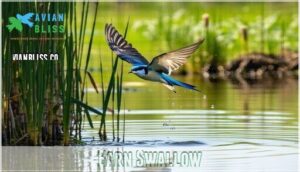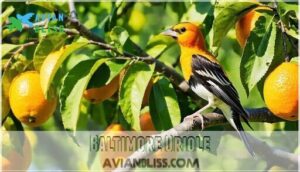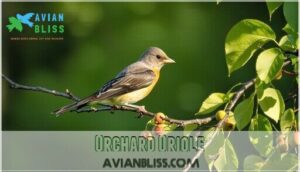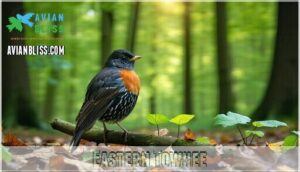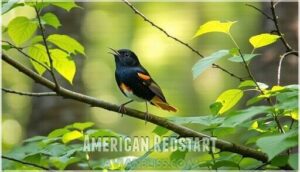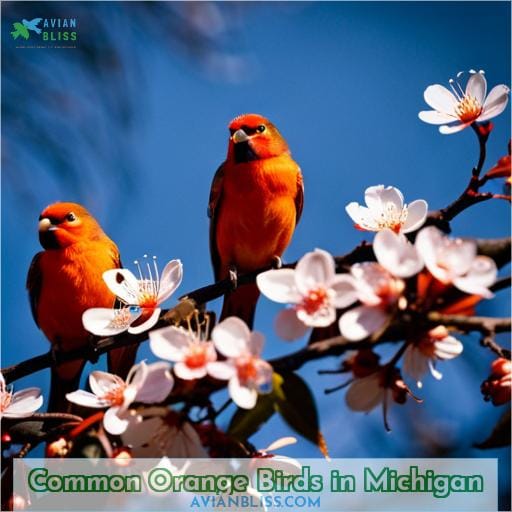This site is supported by our readers. We may earn a commission, at no cost to you, if you purchase through links.
 You seem thrilled by that flash of orange you glimpsed in the trees. I hear your curiosity – let’s identify which beautiful bird graced your sight! Michigan hosts a diversity of orange-feathered species.
You seem thrilled by that flash of orange you glimpsed in the trees. I hear your curiosity – let’s identify which beautiful bird graced your sight! Michigan hosts a diversity of orange-feathered species.
As an avid birder in this state, I can guide you through distinguishing markings, sounds, and habits of suspects.
The most common orange birds here are Northern orioles, scarlet tanagers, and American robins. However, we must rule out rarer visitors too. Orange plumage blazes on indigo buntings, rose-breasted grosbeaks, and orange variant eastern bluebirds.
The adventure is afoot!
Table Of Contents
- Key Takeaways
- American Robin
- Barn Swallow
- Baltimore Oriole
- Orchard Oriole
- Red-breasted Nuthatch
- Eastern Towhee
- American Redstart
- Blackburnian Warbler
- Types of Orange Birds Found in Michigan
- Common Orange Birds in Michigan
- Frequently Asked Questions (FAQs)
- What is the size comparison between a Baltimore Oriole and an Orchard Oriole?
- What is the preferred nesting habitat for Barn Swallows?
- How do American Redstarts attract insects for food?
- What is the migratory pattern of Blackburnian Warblers in Michigan?
- Do all orange birds in Michigan have orange underparts?
- Conclusion
Key Takeaways
- Michigan is home to a variety of orange-feathered bird species, including Northern orioles, scarlet tanagers, and American robins.
- Baltimore orioles are the most distinct orange birds in Michigan, with bold black bibs and burnt orange plumage.
- Attracting orioles to your yard can be done by providing specialized feeders with their favorite foods and planting native trees and shrubs.
- Observing orange birds in Michigan can provide a sense of connection to nature and an appreciation for their beauty and adaptability.
American Robin
American Robins are one of the most familiar orange-breasted birds you’ll see in Michigan. Their range covers the entire state, so watch for these chunky, rusty thrushes hopping on lawns or nesting in backyards from Detroit to Marquette.
Most Familiar ORANGE Birds in Michigan
You would likely recognize the rusty orange breast of the American Robin, a familiar backyard visitor that often nests near people and enjoys bathing in backyard drippers. The Robin’s cheery song resonates from forest edges to backyards, but their preferred forest habitat is steadily being lost.
Deforestation and urbanization pressure Robins and other colorful songbirds like the American Goldfinch and Baltimore Oriole. Even climate change alters migration and breeding ranges. Enjoy these beautiful birds while supporting conservation of their increasingly fragmented habitats.
Range Map
Folks, this familiar breed blankets the mitten state come springtime, its melodious carols announcing the return of warmer weather.
Robins are the first birds to sing at dawn, greeting each new day with enthusiasm. Their cheery song lifts spirits darkened by long winter months. Watching their vigor gathering worms on newly thawed lawns stirs hope.
We rejoice at their return, heralding nature’s renewal.
American Robins breed across North America. In winter, they vacate Canada and northern states, migrating south through Michigan. Their range spans the continent, from Alaska to Guatemala. Abundant and adaptable, they thrive near humans.
But habitat loss and climate change impact populations. Conserving wetlands and forests ensures future generations enjoy the Robin’s welcoming song.
Barn Swallow
Let’s see some swallows following mowers for stirred up insects this summer! Barn Swallows, with their rusty orange throats and bellies, are a common sight near water in Michigan. These agile birds have specific habitat preferences and often nest in barns or under bridges.
They exhibit interesting behavior when it comes to feeding habits as well. Barn Swallows are known for their ability to catch insects on the wing and will eagerly follow mowers that disturb the bugs they rely on for sustenance.
During migration patterns, you can spot these vibrant orange birds flying south during winter months to seek warmer climates where insect populations remain plentiful. Their range spans across much of North America, but they particularly thrive in open areas like fields and wetlands.
The presence of barn swallows not only adds beauty to our surroundings but also serves as natural pest control by keeping insect populations at bay. So next time you’re out enjoying the outdoors in Michigan, keep an eye out for these graceful flyers performing acrobatic maneuvers while helping maintain a balanced ecosystem through their feeding habits.
Baltimore Oriole
When it comes to the brightest orange bird in Michigan, look no further than the Baltimore Oriole. Attracting these stunning birds can be as simple as offering slices of oranges or jelly in your backyard feeders.
Brightest ORANGE Bird in Michigan
Take a moment to imagine the most vibrant, eye-catching bird you’ve ever seen in your backyard. Picture a flash of brilliant orange soaring through the air, catching your attention with its radiant plumage.
This is none other than the Baltimore Oriole, one of Michigan’s brightest orange birds.
As fall approaches and many birds embark on their annual migration southward, these stunning orioles can be spotted making their way through our forests and urban areas alike.
During winter months when other species have migrated away from Michigan’s cold climate, some orange birds still brave the elements in search of food and shelter. The Cooper’s Hawk stands out with its reddish barring below as it stealthily hunts for prey amidst snowy landscapes.
Another resident that adds a pop of color to our winters is the Orchard Oriole; while males sport vivid orange feathers, females display greenish hues.
In Michigan’s lush forests where tall trees create an enchanting canopy overhead, several species proudly showcase their bright orange plumage all year round. These include not only Orioles but also Blackburnian Warblers with yellow-orange faces/throats and Red-breasted Nuthatches displaying vibrant orange underparts amid conifers.
Even within urban areas across Michigan cities such as Detroit or Grand Rapids where nature finds ways to coexist among concrete jungles, brightly colored migratory songbirds like Baltimore Orioles can be found nesting throughout summer months.
They are often attracted by fruit feeders filled with juicy slices or sweet jelly. Observing these remarkable creatures brings us closer to nature, powerful beings who adapt, cross boundaries, and imprint themselves powerfully upon our memories.
Attracting Orioles
If you really want to have a front-row seat to an orange-feathered fashion show in your backyard, it might be worth setting up a buffet of delectable treats like juicy fruit slices and sweet nectar.
Attracting orioles can be as simple as providing specialized Oriole feeders filled with their favorite foods. These vibrant birds are known for their unique nesting habits. They often build hanging nests at the end of tree branches.
They also have interesting migration patterns, with many northern Orioles flying south for the winter.
Creating an oriole-friendly yard involves planting native trees and shrubs that provide food sources and cover for these beautiful orange birds. With strategically placed bird feeders filled with enticing goodies, you’ll soon find yourself surrounded by these stunning Michigan residents.
Orchard Oriole
Moving on from the vibrant Baltimore Oriole, let’s explore another fascinating orange bird that can be found in Michigan – the Orchard Oriole. With its striking combination of orange plumage for males and greenish tones for females, this species stands out in any woodland setting.
Identifying characteristics include a smaller size compared to other orioles and a slightly rounded shape. Orchard Orioles prefer high tree canopies where they build their nests using grasses and plant fibers.
When it comes to mating behaviors, male orchard orioles use their vivid colors to attract mates through elaborate displays of singing and flapping their wings vigorously. They are known to migrate long distances during springtime from Central America all the way up into Michigan.
In terms of food preferences, these birds have a taste for insects but also enjoy sipping nectar from flowers like trumpet vines or honeysuckles.
So if you spot an elegant small-sized bird with bright orange feathers darting among treetops while emitting melodious songs, chances are you’ve encountered an enchanting Orchard Oriole amidst its natural habitat here in Michigan!
Red-breasted Nuthatch
Explore the enchanting world of the Red-breasted Nuthatch, with its vibrant underparts akin to a fiery sunset, as it flits and forages amidst the towering conifers. This captivating bird exhibits fascinating behavior that will leave any birdwatcher in awe.
Behavior: The Red-breasted Nuthatch is known for its agile acrobatics as it hops headfirst down tree trunks in search of insects and seeds.
Habitat: These delightful creatures prefer coniferous forests where they can find ample food sources and suitable nesting sites.
Migration patterns: Unlike some northern birds that migrate south for winter, Red-breasted Nuthatches are mostly non-migratory but may occasionally move southward during irruption years when their primary food supply becomes scarce.
Nesting habits: They construct their nests using bark strips or twigs lined with fur or feathers deep within tree cavities or old woodpecker holes.
Diet: Their diet primarily consists of insects, spiders, seeds from pine cones, and occasionally small berries.
With their striking red feathers contrasting against a backdrop of greenery, observing these charismatic birds provides an unparalleled experience in nature’s grand theater.
Eastern Towhee
When studying and identifying wild bird species in Michigan, one of the largest sparrows you may come across is the Eastern Towhee. Known for its chunky build and rusty orange sides, this bird can be found in brushy areas where it scratches leaves for food.
Identifying Characteristics
Observe the unique characteristics of orange birds to accurately identify them and appreciate their beauty. When identifying orange birds, it is helpful to consider their dominant color and color patterns.
The Eastern Towhee, for example, has rusty orange sides that make it easily recognizable. Additionally, examining the feathers can provide clues for species identification. To attract Orioles in Michigan, offer fruit such as oranges or jelly in feeders.
One of the Biggest Sparrows in Michigan
Imagine encountering a sparrow that is as big as your hand and has a distinctive call that sounds like it’s shouting Drink your tea! The Eastern Towhee, one of the biggest sparrows in Michigan, stands out with its size and unique vocalization.
Found in brushy areas, this bird prefers dense shrubs for nesting. During migration, they move south to warmer regions. Their diet consists of insects and seeds. Males have bold black-and-orange plumage while females are more subdued.
Other orange birds found in Michigan include the yellow warbler, pine warbler, cedar waxwing, palm warbler, and northern cardinal.
American Redstart
Moving on from the Eastern Towhee, let’s delve into another captivating orange bird found in Michigan: the American Redstart. This small warbler is a sight to behold with its black plumage adorned by vibrant orange patches.
Its striking appearance makes it easily identifiable among other woodland species.
The American Redstart can be spotted in open woods where it flits about, startling insects into flight and capturing them mid-air with swift precision. During the breeding season, these birds create melodic songs consisting of high-pitched notes that echo through their preferred habitat of shrubby areas and forest edges.
As North American migrants, they embark on long journeys each year to Central America or even as far south as South America for wintering grounds before returning north once again in springtime.
In terms of feeding habits, the redstarts are primarily insectivorous but will also consume berries when available during migration periods or if insects become scarce. Their agile nature allows them to capture flying insects effortlessly while hovering midair.
The males play an active role during courtship displays where they perform aerial acrobatics showcasing their bright plumage and singing distinctive melodies that fill the air.
Observing these unique characteristics such as their striking coloration, breeding behaviors, song patterns, and migratory routes can help bird enthusiasts identify this beautiful species amidst other avian inhabitants within Michigan’s diverse landscape.
Blackburnian Warbler
Look for the vibrant yellow-orange face and throat of the male Blackburnian Warbler as it flits through the mixed forests. This stunning bird can be identified by its distinct features, which include a bold black crown and back, contrasting with its bright orange breast.
The Blackburnian Warbler is known for its preference for high elevation coniferous forests during the breeding season but can also be found in deciduous trees during migration periods. These warblers are migratory birds that travel long distances from their wintering grounds in South America to breed in North America.
During this time, they engage in impressive courtship displays to attract mates.
In terms of food preferences, these warblers primarily feed on insects but will also consume nectar when available. While observing these beautiful birds, keep an eye out for other species such as the yellow-rumped warbler or pine siskin that may share their habitat along with more common Michigan residents like American robins or house finches.
Types of Orange Birds Found in Michigan
Explore the fascinating world of orange birds found in Michigan, including the majestic American Kestrel and the stealthy Cooper’s Hawk. These unique species offer a thrilling challenge for bird enthusiasts with their distinctive colors and behaviors.
American Kestrel
When you spot a small, falcon-like bird with vibrant orange and blue-gray feathers in the sky, you may have come across an American Kestrel. This stunning bird is known for its identifying characteristics, such as its sharp beak and long wingspan.
With their hunting behavior, they swoop down from above to capture insects and small mammals. American Kestrels are found throughout Michigan, according to their range map. They nest in tree cavities or abandoned nests of other birds.
To attract kestrels to your backyard, consider providing nesting boxes specifically designed for them. Also, offer a variety of food sources like seeds and suet cakes that will also entice other species, such as yellow birds like the ruby-throated hummingbird or black-throated green warbler.
By creating an inviting environment filled with native plants that produce berries or flowers rich in nectar during different seasons, you can increase your chances of attracting not only males but females too who are looking for suitable nesting grounds.
When observing these magnificent creatures soar through the skies, you’ll feel a sense of liberation while gaining power by understanding more about this majestic species.
Cooper’s Hawk
You’ll be amazed by the striking reddish barring on the Cooper’s Hawk’s underside, making it a true ambush hunter in Michigan. This magnificent bird can be easily identified by its unique characteristics. Unlike the American Kestrel, which is small and colorful, the Cooper’s Hawk stands out with its powerful presence and intense gaze.
Its hunting behavior is unparalleled as it swiftly swoops down on unsuspecting prey from above. Found throughout Michigan, this species prefers wooded areas where it can blend seamlessly into its surroundings.
During migration periods, these birds travel south to warmer regions for winter before returning again in springtime.
To distinguish between male and female Cooper’s Hawks may prove challenging due to their similar appearance; however, males tend to have slightly smaller bodies compared to females yet both possess that remarkable reddish barring underneath their plumage.
When observing these fascinating creatures of flight within your backyard or local park, you may notice they are often seen near bird baths as they enjoy bathing while also using them as a source of hydration during hot summer days.
Creating an inviting environment for these black birds involves planting native plants that provide shelter and food sources such as berries or insects, attracting not only our resident raptors but many other avian species who share habitats among us humans.
Incorporating various elements like feeders containing different types of seeds, nuts, suet, and fruits will attract a multitude of diverse wildlife, including our beloved orange-colored friends among others.
If you find yourself fortunate enough to witness one up close, you’ll undoubtedly appreciate their vibrant colors, and if given time, may even develop an understanding about how truly extraordinary nature can be.
Common Orange Birds in Michigan
When it comes to attracting birds to your yard in Michigan, it’s important to know the common orange species that you might encounter. From black and orange birds like orioles and towhees, to yellow and orange warblers, understanding the various colors and patterns can help you identify these beautiful feathered visitors.
Keep an eye out for birds with an orange breast such as robins or nuthatches, as well as other unique orange species like kestrels or swallows.
Attracting Birds to Your Yard
To attract various avian species to your yard, provide a diverse range of native plants for food and nesting. Use bird feeders, baths, and houses. Consider attracting brown thrashers, common yellowthroats, great crested flycatchers, and wood thrushes among the many yellow birds that may visit.
Black and Orange Birds in Michigan
Explore the vibrant world of black and orange feathered wonders that grace the skies of Michigan with their beauty. With their distinctive colors, these birds are easy to identify. The range map shows where you might spot them in Michigan.
Attracting orioles is a great way to add more color to your yard. Did you know that one of the largest sparrows in Michigan is also black and orange? By providing food, water, and shelter, you can create a welcoming environment for these stunning creatures.
Yellow and Orange Birds in Michigan
Discover the vibrant hues of yellow and orange that grace the skies of Michigan. These birds bring joy with their unique identifying characteristics, range maps, and tips for attracting orioles.
Birds With an Orange Breast in Michigan
Imagine spotting a vibrant splash of color in the trees, an eye-catching burst of brightness that immediately captures your attention. This is the orange breast of common birds found in Michigan. The American Robin, Baltimore Oriole, and Red-breasted Nuthatch are just a few examples.
Their identifying characteristics include rusty orange underparts and distinct behaviors such as nesting near people or scratching leaves for food. To attract Orioles to your yard, offer orange slices or jelly feeders. These birds can be seen across Michigan according to their range map and are among the biggest sparrows you’ll encounter here.
Other Orange Birds in Michigan
Spotting vibrant feathered creatures can be quite thrilling, especially when you come across small falcons with blue-gray plumage or cunning hunters with reddish barring below.
- American Kestrel: Small orange/blue-gray falcon
- Cooper’s Hawk: Reddish barring below, ambush hunter
- Migratory Patterns: Northern birds migrate south for winter
With their unique identifying characteristics and migratory patterns, these common orange birds in Michigan add a burst of color to the landscape. Attracting orioles can be achieved by offering fruit slices and jelly feeders. A range map will help bird enthusiasts locate these stunning species throughout the state.
Frequently Asked Questions (FAQs)
What is the size comparison between a Baltimore Oriole and an Orchard Oriole?
Looking to compare the sizes of Baltimore Orioles and Orchard Orioles? Well, let me ask you this: Can you imagine a bird with bright orange and black plumage compared to one with orange males and greenish females?
What is the preferred nesting habitat for Barn Swallows?
Barn Swallows prefer nesting near bodies of water, such as lakes or rivers. They build their nests on structures like barns or bridges, providing them with easy access to open areas where they can catch insects for food.
How do American Redstarts attract insects for food?
To attract insects for food, American Redstarts use their striking black and orange plumage to startle them into flight. They dart around in open woods, showcasing their vibrant colors and agile movements, making it impossible for insects to resist.
What is the migratory pattern of Blackburnian Warblers in Michigan?
Blackburnian Warblers in Michigan have a migratory pattern that symbolizes freedom and exploration. These vibrant birds embark on an epic journey, leaving the northern regions to seek warmer climates during winter, showcasing their inherent power and adaptability.
Do all orange birds in Michigan have orange underparts?
Not all orange birds in Michigan have orange underparts. While some species like the Baltimore Oriole and Red-breasted Nuthatch do, others such as the American Robin and Eastern Towhee have different color patterns.
Conclusion
To truly appreciate the vibrant beauty of Michigan’s orange birds, you must delve into their world. From the familiar American Robin with its turquoise eggs to the elusive Baltimore Oriole, these birds captivate with their stunning orange hues.
Whether you’re attracting orioles with orange slices or observing the Red-breasted Nuthatch at your feeder, studying and identifying these birds requires expertise.
As you explore the diverse range of orange birds in Michigan, from the Barn Swallow near water to the Blackburnian Warbler in mixed forests, you’ll gain a deeper understanding of their behavior and habitat.
So, venture into the world of Michigan’s orange birds and let their vibrant colors and enchanting presence bring joy to your birdwatching adventures.

